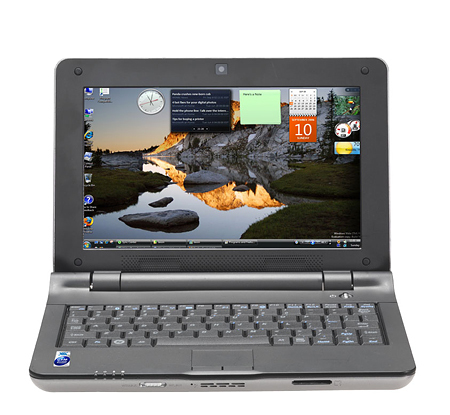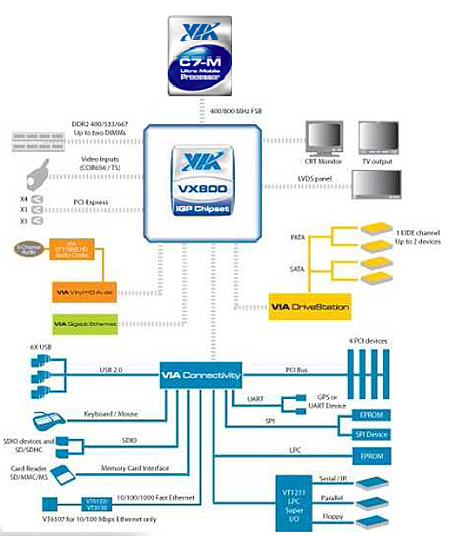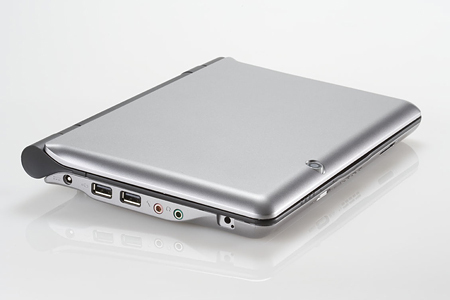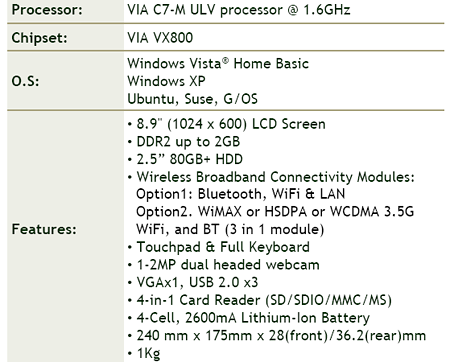First Look: VIA OpenBook Mini-Notebook
Introduction
A week or so ago, representatives of VIA Technologies, Inc. visited us to show off their OpenBook reference design. VIA designed the mini-notebook to demonstrate to manufacturers what is possible in an ultra-portable computer. You can’t buy the OpenBook directly from VIA, but you’ll see it or concepts in the OpenBook in products from other manufacturers soon. The OpenBook is 9.5" wide by 6.9" deep and 1.1" to 1.4" high. It weighs about 2.2 pounds. The display measures 8.9" and features a resolution of 1024x600. All images courtesy VIA Technologies, Inc.
The CPU
The VIA OpenBook reference design is built around the company’s C7-M ultra-low voltage CPU. The C7-M is available in speeds from 1.0 to 1.6 GHz. VIA claims that the CPU’s maximum power consumption is 3.5 watts at full power and as low as 0.1 watts during idle. The CPU comes in a small 21 mm x 21 mm package.
The "Chipset"
We apologize for the quality of this diagram, but it is still possible to discern key features of the VIA CPU-"chipset" combination that powers the OpenNote. The VX800 integrates North and South bridge technology into a single package that measures 33mm x 33mm. The VIA Chrome 9 integrated graphics processor supports DirectX 9.0 and the VIA Chromotion CE video display engine supports hardware decoding acceleration of MPEG-2, MPEG-4, WMV9 and VC1 video formats.
The Keyboard
The VIA OpenBook reference mini-notebook’s keyboard doesn’t take advantage of the full width of the case as does the HP 2133 Mini-Note, which features VIA’s C7 CPU.
The Hardware
VIA’s OpenBook reference mini-notebook specs a 2.5" 80 GB hard disk drive, up to 2 GB of DDR2 memory, a 1.2 MP dual headed webcam, a 4-cell 2600 mAh lithium-ion battery with a claimed life of 3 hours and support for Bluetooth, WiFi and LAN connectivity, with optional WiMAX or HSDPA or WCDMA 3.5G. This is one of the few mini-notebooks that fully exploits the breed’s portability by offering a full range of wide area networking options.
More Hardware
The left side of the VIA OpenBook includes a DC power jack, two USB 2.0 ports and inputs for a microphone and headphones.
Still More Hardware
The right side of the VIA OpenBook reference unit features a third USB 2.0 port, a 10/100 Ethernet port and a VGA connector for an external monitor.
Get Tom's Hardware's best news and in-depth reviews, straight to your inbox.
Basic Specs
Basic Specifications
The VIA OpenBook reference model runs an impressive range of operating systems: Vista and XP, as well as three flavors of Linux.
More Detailed Specs
-
humalong hmm, yea it looks like the Asus EEE PC, which has been out for a long time. I suppose if you want to buy a version that doesnt work as well and has components that will likely fail after only 6 months, than go with VIA. though i admit, the VIA clone is a little better looking...Reply -
xxchocotacoxx humalonghmm, yea it looks like the Asus EEE PC, which has been out for a long time. I suppose if you want to buy a version that doesnt work as well and has components that will likely fail after only 6 months, than go with VIA. though i admit, the VIA clone is a little better looking... Yeah, it looks like an EEE PC, but with a larger screen (than initial models), larger HD, larger keyboard, larger casing, larger assortment of connectivity options, higher clock speed, possibly longer battery life, addition of separated left and right mouse buttons, and altered port locations.Reply
But besides all that, it looks like an EEE. -
velocityg4 What I do not get with these tiny Mobile computers is they use less energy but then the twits put smaller batteries in too.Reply
How about just slighty larger or thicker laptop with a full size battery. Then it can still be smaller and lighter than traditional laptops with an 8+ hour battery life.
This is what really keeps me away from these tiny laptops why would I want a small screen cramped keyboard and crappy battery life. One of the points to these is to be free of wires.
Heck just give us nuclear batteries than we can have 10-20 years of charge and never need to plug in. We'll just put terrorists on the honor system. :o -
humalong true it has superior specs. but your point about everything being bigger is kind of odd, considering that its marketed as mini.Reply
if you want everything larger, buy a normal laptop?
-
razor512 spongebobMoreThenOneParagraphperpagePlease?Reply
They divide pages by topic, not length, this allows the article to be more organized and less clutters. On this site, a page can be 10,000 words long or just 50 words long -
razor512 velocityg4What I do not get with these tiny Mobile computers is they use less energy but then the twits put smaller batteries in too.How about just slighty larger or thicker laptop with a full size battery. Then it can still be smaller and lighter than traditional laptops with an 8+ hour battery life.This is what really keeps me away from these tiny laptops why would I want a small screen cramped keyboard and crappy battery life. One of the points to these is to be free of wires.Heck just give us nuclear batteries than we can have 10-20 years of charge and never need to plug in. We'll just put terrorists on the honor system. yep it is annoying when they do that.Reply
when ever they make a smaller chip they feel the need to make the device a mini
use 50% less power so they decide to use a 50% smaller battery
when they do this then all you are getting out if it is a smaller device that has less functionality. keep a full sized laptop with the lower power usage components
i wouldn't mind that hardware in a full sized laptop, the performance is still good for any normal use and it is like i will be working with MAYA 3d or adobe after effects or doing real time croma keying with a HD cam
how about a cpu like that with a built in speed controller, where you can set the speed to 600MHz or less to save even more power. don't need 1.6GHz to use ms word or watch a video (most videocards have hardware acceleration for video (for me HD video uses only around 5% cpu usage ) -
Does a book make noise? Get your metaphors right. This is a unicycle or, more likely, a bicycle.Reply
-
spiralsun1 I want a mini laptop so bad, but the battery life is the #1 key drawback. Under 6 hours is just plain unacceptable. 8 hours would be ideal. I want to charge overnight and use the laptop all day. At the very least offer a big battery as an option! It is crazy that no one is doing this!Reply








